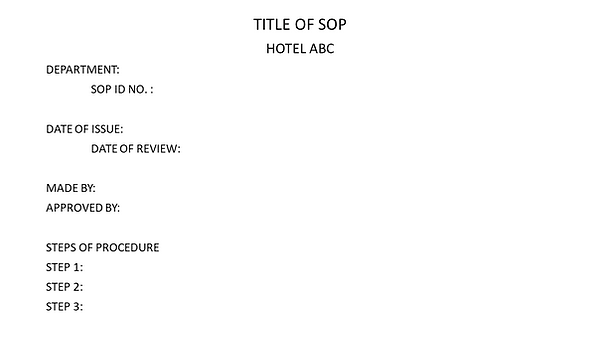Unit 2: Managing F&B Outlet
Supervisory function is an essential activity performed by the supervisory staff to check if all the tasks of F&B service are carried out according to the standards set, so as to satisfy the customer and make them feel that they have received the money’s worth.
Supervisory Function in Food Service Operations
Briefing
All wait staff are expected to attend the briefing in proper attire and conducted by the supervisor prior to the service. During the briefing the supervisor verifies the personal grooming of the staff to ensure the wait staff is in an acceptable condition After checking the personal grooming the supervisor briefs the wait staff on number of covers, profile of guests, service procedure, dishes that are to be concentrated during suggestive selling, dishes that are not available and anything pertaining to the restaurant policies and food service. Allocation of tables is also done during briefing.
Checking mise en place and mise en scène
Mise en place means keeping everything required in readiness for service which comprises list of activities. Mise en scene refers to keeping the area clean and presentable. These activities are carried out prior to service. It is the responsibility of a wait staff to carry out all the activities to an acceptable level. The head waiter prepares duty rota to show the assignment of task to staff.
Handling of Tips
Tips are the amount given voluntarily by the guest at the end of the meal or function to the service staff appreciating their good work. In most hotels, tips are taken only by the service staff and not shared with kitchen staff
Stock Taking
The supervisor must maintain the stock of all area under his/her control. It should be taken periodically at least once a week. This work should be assigned to a team of or three staff in rotation.
Requisitions
Supplies required during service are requisitioned from the stores by the supervisor. Supplies in the service area include edible and miscellaneous items. Edible supplies are sugar, proprietary sauces, salt pepper, butter Miscellaneous Supplies include paper napkins’ doily straws placements tooth pick etc.
Sales analysis
This is the most important function of a supervisor. The supervisor must analyze the sales at the end of the day, week, and month in order to be aware of the following:
-
Actual Sales and budgeted sales
-
Fast moving dishes
-
Dead dishes
-
Average Revenue per waiter
-
Least revenue generating waiter
-
Most preferred tables.
-
Slow moving dishes
Cost analysis
Cost refers to expenses incurred in producing an or serving goods. In food service it includes all expenses that occur right from procurement of raw material to washing the soiled plates of the guests. Every employee should be committed towards containing of cost so as to earn more margin of profit. There are basically three types of cost
-
Food Cost
-
Labour Cost
-
Over head Cost
Handling Complaints
Success of food and beverage operations is ensured when the needs and the expectation of the guest are met. Complaints from food and beverage operations are basically of two types
-
Food-related
-
Attitude related
It is the duty of the service staff to analyze the root cause of the problem for the complaints and take necessary actions and ensure complaints do happen again. All complaints made and action taken should be recorded in a notebook.
Training the staff
All employees of an organization must be trained continuously so as to deliver the products and services as per the standards set by the organization.
Managing Discipline
Discipline is the hallmark of a good hotelier. Following are some general guidelines to maintain a disciplined team
-
Ensure that there are written house rules and code of conduct.
-
Motivate staff to follow rules
-
A fault committed must be checked at once
-
Always be disciplined. Set an example in front of juniors.
Staff Scheduling
A supervisor must be aware of peak days and rush hours to do the staffing accordingly. Forecasting busy schedules and staffing accordingly is the key to success. Few points to be kept in mind are as follows
-
The schedule should be displayed well in advance
-
Staff distribution should be optimal.
-
Holidays should be evenly distributed
-
Staff should be rotated in each shift
Supervisory functions ensure smooth operation of any organization. These functions vary from organization to another. Supervisors are expected to guide the subordinates towards the attainment of objectives.
A standard operating procedure (SOP) is a set of written instructions that document a repetitive activity followed by an organisation.The development and use of SOP are an integral part of a successful quality system as it provides individuals with information to perform a job properly and facilitates consistency in the quality of a product or service.
Writing an SOP
-
SOPs should be written in concise, step by step, easy to read format. The document should not be wordy or over lengthy.
-
SOPs should be written with sufficient details so that anybody with limited experience or knowledge can successfully reproduce the work when unsupervised. These SOPs should be made available for reference. SOPs should periodically be revised to keep them updated
Every organisation has its style of writing an SOP. There are no ideal or correct formats. Following is a sample format.

How to write a good SOP
-
Use Job Titles and not names of people
-
Follow a logical thought process.
-
Start each step of the procedure with an action word. For example, lift, pour, etc
-
Use graphics and visuals
-
Sentences should not be long and complicated



